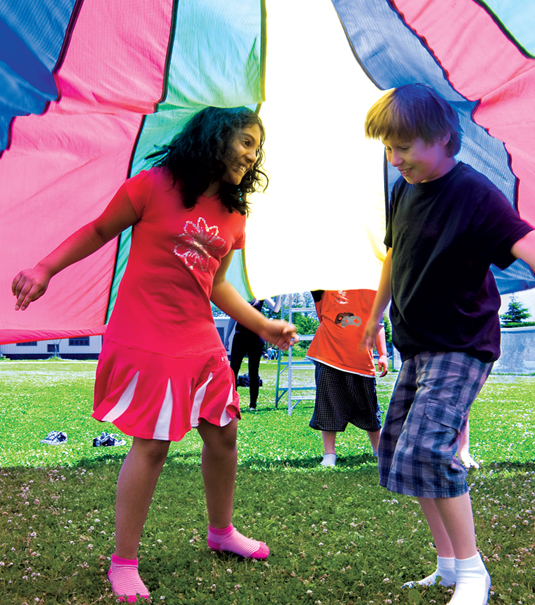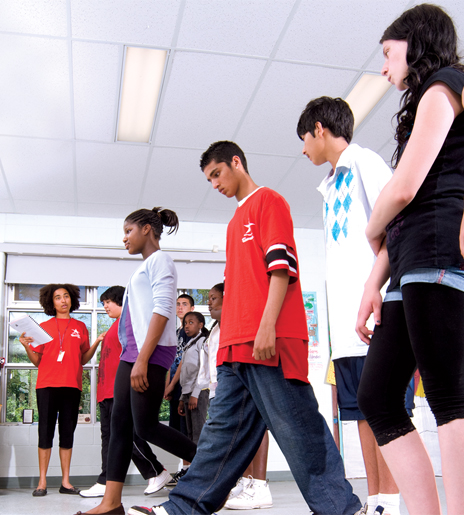|
Letters of Distinctionby Stuart Foxman |
Here’s a game you may not want to play, but it can teach something worth understanding. It’s called Rat Race. Rat Race is part of the training for teachers who accompany students from Grades 7 and 8 to the Students Together against Racism (STAR) leadership camp. Teachers choose potential leaders from 30 schools across the Durham DSB to attend a four-day retreat each fall in a classic lake-creek-and-woodland camp setting, most recently in Haliburton. In order to take part in the program, teachers must first learn about the diversity and inequity in their own social settings. Teachers stand shoulder to shoulder across the width of a room. The game leader calls out instructions. Take steps forward or back according to your life experience. One step forward if you lived with both parents as a child. One step forward if anyone got paid to do housework in your home. One step back if you are first-generation Canadian. The instructions continue, up to 50 or 60 of them in rapid succession until the room has been sorted. In the end, the game leader stands at the front of the room and tells participants he has a job everyone wants, with a good paycheque and high status. The first one to reach him gets the job. One-two-three run! Rat Race is a kinesthetic immersion in the basic concepts of equity and diversity. Deconstructing this simple exercise can give teachers a stark illustration of the impact of such factors as social standing, race and class on their students’ achievements. Is the race to the swift, or has the deck been stacked? How do the people at the back of the room respond? Do they try to run even faster, or do they give up, as the race seems pointless? An honesty gameWhen the students arrive for STAR camp, they are placed in groups away from their schoolmates to participate in orientation and trust-building exercises. The ice is breaking with laughter as they start the game, Crossing the Line. The facilitator calls out instructions. Cross the line if you’ve ever been laughed at for the food you eat. Cross the line if you speak more than one language, if you’ve ever been bullied, if you’ve ever bullied anyone else. “It’s an honesty game,” says Liz Mulligan, OCT, a Grade 4 teacher at Altona Forest PS in West Pickering, who attended her first STAR camp last fall. “As you cross the line, everyone looks.”
“They get to see patterns, and they see that they are not alone,” adds her colleague Marie Thomas, OCT, a Grade 7 and 8 Core French and language teacher. Their school serves, as Thomas puts it, “many who are marginalized, culturally and socially.” Thomas has been teaching for 10 years and came to Ontario by way of Trinidad and then Québec, where she trained in ESL at McGill University. She has been accompanying students to STAR camp for four years and has been on the organizing committee for three of them. She now trains senior high school students to be STAR camp counsellors and runs the on-site, overnight program for teachers. I have a dreamTaking a project back to your home school is part of the STAR strategy. For the past four years Thomas has inspired her entire school to join in her annual I Have a Dream assembly, coinciding with Martin Luther King’s birthday in January. All 450 students at Altona Forest PS write speeches about their dreams for the future. A selection of the Grade 8 speeches is featured at the assembly. “This year several students had a dream that the war in Palestine would end. The dreams all come from personal experience, and when we associate their speeches with Martin Luther King’s, they feel validated. Previously silent students find their voices.” Mulligan attended STAR camp because she wanted to learn about racism: “Being a white female, I’ve never experienced it.” There, she found racism positioned within a spectrum of advantage and disadvantage – as part of a larger picture, including but not limited to race and religion.
“It was interesting to learn that every participant – teacher and student – came in with some baggage, a feeling that they had not been accepted somewhere along the line because of who they were. It wasn’t just the student wearing hijab or the one in the wheelchair who didn’t feel safe.” Still, within the current Canadian context, the student (or teacher) in hijab or in a wheelchair will likely experience more barriers to success than others. And for Durham DSB’s equity, diversity and race relations officer, Philip Howard, OCT, an understanding of systemic barriers is essential. “If students miss the systemic aspect of inequity and focus only on overt bigotry,” says Howard, “they’ll miss 80 per cent or more of the ways in which inequity presents itself in the contemporary world.”
|
 |
 |
Edson Breceda, above, acts the part of mayor as students in his Grade 8 class compete in teams |
To construct new communities – playing the City Game at Dr. Roberta Bondar PS in Ajax. |
The project has had an impact on the whole school. “Making the video allowed us all to talk openly about racism,” Schoemer says. “People don’t want to talk about racism so you have to lay it on the table. The video created a context.”
While she appreciates the recognition and is proud of her students’ work, Schoemer retains a sense of proportion. “Lots of people do these things in their classrooms and don’t get recognized.” She emphasizes that there are many ways of introducing equity into classroom discussion. “It’s not about doing something showy. It can be as simple as allowing everyone to have a voice.”
Developing capacity
Schoemer credits OISE for giving her tools to tackle equity issues. “We were taught to look for missing perspectives, to develop critical thinking. To ask: Who is telling the story? Whose voice is missing?”
Natalie Middleton, OCT, has learned this lesson as well and gives credit to a workshop called Diversity Matters run by her board, the Greater Essex County DSB.
“You start by examining yourself, your own biases and prejudices.”
Middleton teaches English and literacy skills at Century SS in Windsor. Like Schoemer, Middleton has always been interested in social justice. “I went into teaching because of the potential to touch a future generation.”
The Greater Essex County DSB serves the fourth most diverse community in the province. Black Canadians have settled here for nearly 200 years and, as an industrial centre, the region attracted waves of immigration in the 20th century. Now, as many families face job losses, stresses increase for students, but problems can be hard to recognize.
“Teachers can inadvertently promote the status quo with words and actions.”
Speaking of her students’ special learning needs, Middleton says, “You can’t bridge a gap unless you can recognize it.” And the statement has wider application.
As teachers learn in the Rat Race game, there is a spectrum of advantage and disadvantage, not all of it visible. “There’s a lot under the surface that you may not at first perceive,” she adds.
Greater Essex County DSB diversity officer, Rachel Olivero, OCT, is the brains and heart behind the Diversity Matters sessions that Middleton attended.
Olivero stresses that diversity is not simply a matter of celebrating other people’s customs on special days.
“Racism exists,” she says. “Teachers can inadvertently promote the status quo with words and actions that are racist in impact if not intent. It’s important to understand that racism is learned – and can be unlearned.”
She points to teachers’ professionalism: Teachers all want to help their students learn, and the point is how best to achieve our goal.
One way is to ensure access to training. Take educators in the Niagara region, for example:
A man walks into a class of 25 administrators and teachers. They are white. He is not. He says, “Identify me – by age, race, ethnic background, sexual orientation.”
Cheryl Caldwell, OCT, recalls, “It made people uncomfortable, afraid to make a faux pas. Then we had to identify ourselves this way – something we weren’t used to.”
Caldwell, a consultant with the Niagara DSB, had been studying Toronto DSB equity policy documents as part of her principal’s qualification when she discovered that her own board didn’t have any, not even hidden in the filing cabinet.
“I realized we had a huge learning curve ahead of us.”
This led her to participate in the six-week course, Foundations in Equity and Anti-Racism, offered by the Canadian Race Relations Foundation.
In Niagara, the demographics have been more homogeneous than in many regions of Ontario, but that is changing. And in a community unused to diversity there is a certain relief to naming the elephant in the room, giving participants the language to address inequities.
Sandy Yep, OCT, who led the Foundations in Equity and Anti-Racism course, is a member of the Antiracist and Multicultural Educators Network of Ontario (AMENO), as is Olivero. This loose-knit collection of teachers and equity officers is front and centre on equity work in our schools – running training workshops, contributing to the Ministry of Education’s curent strategy paper and consulting in the development of guidelines for equity-related AQs. AMENO member Chris D’Souza, OCT, seconded from the Dufferin-Peel Catholic DSB to York University, has been developing an inclusive education module for pre-service teachers which, once approved, will be mandatory.
Modelling equity
So what about diversity among educators themselves in our schools?
The Dufferin Peel board is implementing a mentoring program for racialized teachers who may become administrators.
“They see the importance of increased representation when less than four per cent of teachers are non-white” says D’Souza.
Still, Arifa Ghaffar, OCT, a teacher-librarian at S.T. Worden PS in Courtice, doesn’t believe a mentoring program will be enough.
“Unless there are many more teachers hired – not just in Toronto, not just in Peel, not just in York – unless there is acceptance of the need for change, I don’t think it will make a difference.”
Ghaffar has worked with the Kawartha Pine Ridge DSB for two years under a long-term occasional contract that cannot now be extended, and opportunities are limited.
Since arriving from Pakistan 14 years ago, Ghaffar has faced some blatant racism –“I’ve been called a terrorist, Osama Bin Laden’s sister. It’s because I wear hijab.” – as well as its more subtle forms.
“I went to see a principal about a job. She said, ‘You have all these experiences but we don’t have any Muslim kids here. You should go to Toronto.’ I told her, ‘You don’t have to have Muslim kids – I am a teacher.’”
The issue of role models is important and not just for kids who feel excluded by the system. Ghaffar has certainly made the most of her two-year stint, initiating the school’s first-ever Black History Month projects and two highly successful annual Diversity Days featuring music and art, with rotational workshops for the students in such topics as body image, Islamophobia, the Aboriginal medicine wheel and the world of the Deaf.
“Unless there are real-life role models of different races and religions teaching the kids, they will not be able to embrace diversity because that is not their reality,” says Ghaffar.
Abdelkarim Ouedhrefi, OCT, agrees that role models are important. At collège catholique secondaire Samuel-Genest in Ottawa, he has been teaching in the French-language support programs for newcomers: actualisation de la langue française (ALF) and perfectionnement de francaise (PDF). This year he’ll teach Grade 8 students French, history, geography and religion. It’s an interesting assignment for the only Muslim teacher in this Catholic school, which boasts 48 different ethnicities and cultures.
 |
 |
Teacher-librarian Arifa Ghaffar with students at S.T. Worden PS in Courtice. |
Abdelkarim Ouedhrefi at collège catholique secondaire Samuel-Genest in Ottawa believes role models are important for students, but many communities remain under-represented among teaching staff. |
Born in Tunisia, Ouedhrefi was a youth worker before coming to Canada 17 years ago. “I can identify with my students. My own life path helps me to understand a little their problems and experiences.
“Here in Ottawa,” says Ouedhrefi, “we need all the francophone teachers we can get.” But even so, many ethnic and cultural communities remain under-represented.
“We know that students often identify with their teachers, and if we want to reinforce the sense of participation among students whose families have immigrated, we should be trying for some representation from their communities among teachers.”
A sense of belonging is the central tenet of the concept of inclusive education, but in neither francophone nor anglophone schools does the mix of teachers reflect the student population.
Strengths and challenges
In August 2008 the Toronto DSB won the prestigious Carl Bertelsmann Prize for Commitment to Equity in Education. The German foundation that sponsors the award was impressed with initiatives aimed at reducing obstacles faced by immigrant and at-risk children.
“They were interested that we treat diversity as a strength, not a problem,” says Lloyd McKell, OCT, the board’s executive officer for student and community equity.
However, while diversity may be a strength, poverty certainly is not. And the colour of poverty in urban centres is increasingly non-white.
A Toronto DSB study released in February 2009 showed consistent gaps in standardized Grade 3 test results – with the biggest discrepancies among different racial groups, followed by income groups.
The statistics are grim. What can the school system do to buck this trend?
The Toronto DSB recently set a goal of wrestling its current 40 per cent dropout rate among Black students down to 15 per cent in the next five years. Resources for this battle include the first Africentric social studies curriculum kit for JK to Grade 8, ready for use in all schools with 120 teachers trained to deliver it and an Africentric alternative school slated to open in September 2009.
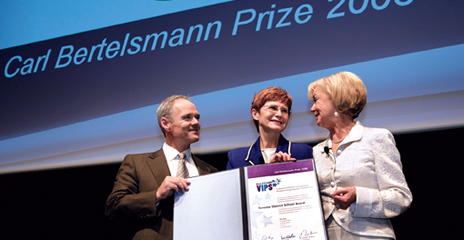 |
From left: John F. Campbell, Chair, and Gerry Connelly, former Director of Education, both of the Toronto DSB, receive the 2008 Carl Bertelsmann Prize from Liz Mohn, Vice-Chair of the Bertelsmann Stiftung. |
At J. Clarke Richardson Collegiate in Pickering, a Black Studies course offered by history and communications teacher Cheryl Rock, OCT, is already making a difference. Developed with colleagues in a local Black educators group, the course has been offered for the past four years.
“There’s an effect on engagement,” says Rock. “At first they are sitting by themselves, don’t know whether to put up their hands or not. Then they begin to challenge each other, help each other.”
Rock also runs the Diaspora Collective, an after-school group for “unconventional leaders” that attracts up to 50 kids every year. A visual artist, Rock uses art and performance to explore issues of identity and difference, challenging the students to answer the perennial question faced by non-white Canadians: “But where are you really from?”
The question of where you are from is not one that francophone teachers tend to unravel with their students. The construction of a Franco-Ontarian identity and culture through language is a large part of the purpose of the francophone school system.
“If there are francophone schools in Ontario, it’s because people fought to have them.”
Nathalie Sirois, OCT, who works for le Centre franco-ontarien des ressources pédagogiques in Ottawa, sees issues of equity and diversity as both quite different and exactly the same in French-language and English-language schools.
The experience and history is indeed different. Her own parents can remember when inspectors were sent to prevent teaching in French in their local schools. The oldest francophone school board – le Conseil des écoles catholiques de langue française du Centre et de l’Est de l’Ontario – only just celebrated its 20th anniversary. Minority language rights in Ontario are a relatively recent and hard-won victory.
Yet, when it comes to diversity, francophone students, like their anglophone compatriots, are pouring into the school system from all over the world and they are joining a proud minority culture where language itself forms a point of commonality.
Mutual pride
At école élémentaire catholique Terre-des-Jeunes in Ottawa, language classes offer strong welcoming and settlement support for newcomers. After a full year of intense half days with their ALF/PDF teacher Jo-Anne Désilets, OCT, students in Grades 1 and 2 are joining in an end-of-year celebration with their regular classes.
Whether her students come from Mexico, Burundi, Rwanda or Lebanon, Désilets aims to facilitate and reinforce their identity and integration specifically as Franco-Ontarians.
“Since francophones are a minority in this province,” says Désilets, “this is something we must promote. Students need to know our history and take pride in it.”
Promoting pride in their new identity, in putting down new roots, includes an understanding that it’s something worth fighting for. “If there are francophone schools in Ontario, it’s because people fought to have them.”
Désilets’s perspective on the intersection of race, class and identity was formed by her childhood in Smooth Rock Falls, north of Timmins, where francophones were an 85 per cent majority.
“But the English were the bosses and always had been. We learned to support each other. I think we understand people who immigrate from other countries because of our own experiences as a minority in this province.”
Sirois agrees: “To think of ourselves as somebody else’s majority – we are in the process of digesting that.”
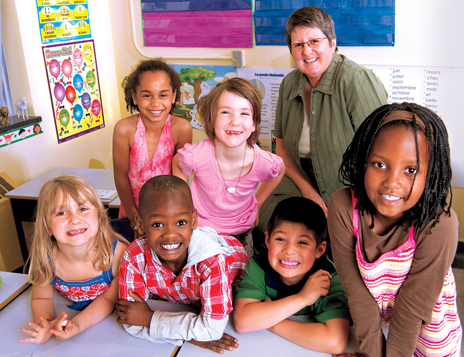 |
Jo-Anne Désilets and her Grade 1 and 2 students celebrate successes – with games, food and certificates of achievement – at école élémentaire catholique Terre-des-Jeunes, Ottawa. |
Nonetheless, there are newly-arrived francophone students who have more than the usual cultural adjustments to deal with. Some have lost parents and family members to war. Some have been witness to genocide, systematic rape and other horrors. Some have been child soldiers.
The needs are great. “We don’t know how to support these kids, what they have seen and lived through,” says Sirois.
To address this lack, she has launched a summer course for teachers in genocide studies. L’Institut canadien pour l’éducation sur les genocides was offered at the University of Ottawa’s faculty of education this summer. Guest speakers included Roméo Dallaire and Barbara Coloroso, whose book about genocide, Extraordinary Evil, was recently translated into French. The course is designed to help teachers recognize and respond to the post-traumatic stress their students may suffer and to address everyday cultural relations in the classroom through the prism of extreme examples of human behaviour, including the Nazi Holocaust.
“When we examine the dynamics of intimidation and hate in a larger society, we must also recognize patterns in a school context – and stop seeing conflict as always between two individuals. This is the relevance of genocide education to teaching practice.”
Medicine wheel
At the bilingual Gron Morgan PS in Thunder Bay, Rachel Mishenene, OCT, is arranging large white, yellow, black and red felt pieces carefully to the north, east, south and west, the four directions of the Native medicine wheel teaching.
Born on Mishkeegogamang First Nation, 500 kilometres north of Thunder Bay, Mishenene is one of about six Aboriginal teachers in the Lakehead DSB.
Today, the sun is shining and Mishenene, an Aboriginal- education resource teacher, has decided to move her class outside. Spring has only just reached their community and the 22 children sitting in a circle on the grass are as bubbly as shaken-up soda pop.
Mishenene explains that the medicine wheel teachings were given to her by an elder from her traditional community, and that the order of the colours and the directions can be different depending on where people come from, their family and their land.
“No one way is the right way,” says Mishenene. She waits for this to sink in and then shows the kids how the four quadrants – the four colours – represent the four quarters of the calendar year, each with its special animal: turtle, eagle, bear and wolf. The colours also represent the four races.
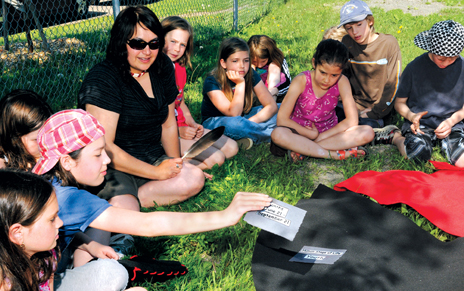 |
Rachel Mishenene shares medicine wheel teachings with students at Gron Morgan PS in Thunder Bay. |
The wheel is non-hierarchical: As it keeps turning, different aspects change in their relationship to the whole.
The students find their place on the medicine wheel and then return to the circle. They learn to talk when holding the eagle feather Mishenene has brought with her and to stay quiet and listen when others speak. The quality of their attention is striking.
“The Aboriginal teachings are not just for people from traditional lands – they’re for everyone,” says Mishenene. As co-ordinator of the Urban Aboriginal Education Project, she has developed curriculum for elementary students, and she recently worked with secondary school teachers to develop a six-day module on treaties, residential schools and the Indian Act for use in the mandatory Grade 10 civics course throughout the Lakehead DSB this fall.
“There are so many ways to see student success – in terms of personal development, confidence,” says Mishenene. “Much of it can’t be measured.”
Still, she thinks the deprivations associated with poverty are the largest threats to success – a link that is clearly measurable.
“We need to know who we are teaching,” Mishenene suggests. “Are the students hungry? Did they stay awake last night because their parents were fighting? What do they and their families need in the way of support?”
Full circle
Achieving equitable and inclusive education in such a diverse province is indeed a challenge. The infrastructure for equity and inclusion has been fragmentary – of 72 boards only 43 have any kind of equity policy in place.
According to Karen Mock, co-chair and guiding light of the Ministry of Education’s recently launched equity strategy paper, Realizing the Promise of Diversity, all that must change by 2010, when equity policies will be required for all boards.
“Aboriginal teachings are not just for people from traditional lands – they’re for everyone.”
Still there is a long road ahead.
“The policy is a great road map but will it go anywhere if the car is out of gas?” This is the wry question posed by Tim McCaskell, former equity officer for the Toronto DSB and author of a history of the board’s struggle for resources and equitable education, who wonders if funding will be adequate to support implementation.
But as vice-principal Ann Kennerley, OCT, from Welland Secondary School emphatically states: “We can’t use funding as an excuse to not have equitable and inclusive schools.”
And all over the province, teachers are working hard to make that equity a reality in their diverse classrooms.
Links
For information on workshops, resources and publications mentioned in this article, follow these links.
Organizations
AMENO, the Antiracist Multicultural Education Network of Ontario is an association of teachers and equity officers across the province. Visit www.ameno.ca.
The Canadian Race Relations Foundation provides workshops, including Foundations of Equity and Antiracism. Visit www.crr.ca or e-mail.
STAR, Students Together against Racism, is an initiative for teachers and students offered through the Equity, Diversity and Race Relations office of the Durham DSB. Visit www.durham.edu.on.ca or e-mail.s
Resources and contests
For J. Clarke Richardson CI’s Black Studies program information, e-mail.
The Lakehead DSB’s Urban Aboriginal Education Project offers elementary-level curriculum and a six-day module for a Grade 10 civics course. E-mail or visit www.lakeheadschools.ca/aboriginal.
Racism Stop It! is an annual video competition sponsored by the Department of Citizenship and Immigration. Visit www.cic.gc.ca/march-21-mars/partcptn/103-eng.asp. The National Film Board offers workshops for those entering the competition.
Professional development
For Diversity Matters workshops of the Greater Essex County DSB, visit www.gecdsb.on.ca or e-mail.
For l’Institut Canadien pour l’éducation sur les génocides, l’Université d’Ottawa, e-mail.
AQs
The College has developed guidelines for a three-part Inclusive Classroom to Schedule D AQ and is processing applications from accredited institutions intending to add it to their program offerings.
Interested members can search at www.oct.ca for a list of providers approved by the College.
Policy papers, reports and publications
Poverty by Postal Code, a 2004 study of Toronto neighbourhoods by the United Way, is available at www.unitedwaytoronto.com.
Race to Equity: Disrupting Educational Inequality by Tim McCaskell, published in 2005 by Between the Lines, is available at www.btlbooks.com.
Realizing the Promise of Diversity: Ontario’s Equity and Inclusive Education Strategy is an Ontario Ministry of Education policy paper released in April 2009. Boards will be required to have equity policies in place by 2010. The paper is available at www.edu.gov.ca.
Reconstructing Dropout is a 1997 report by George Jerry Sefa Dei, Josephine Mazzuca and Elizabeth McIsaac, published by University of Toronto Press. To borrow it from the College library visit www.oct.ca.









